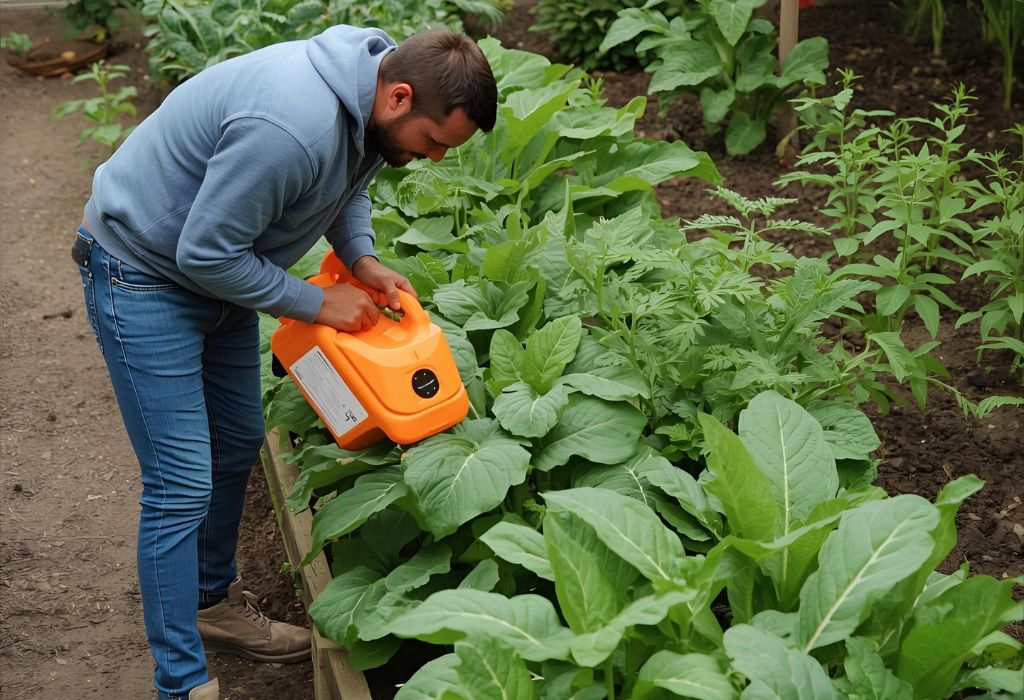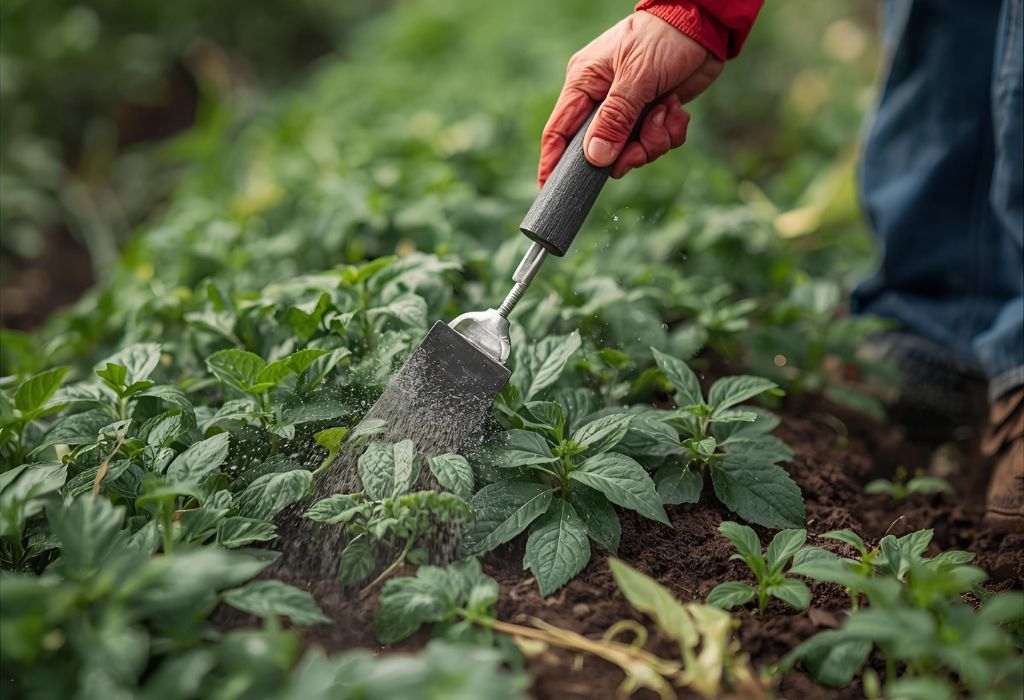A thriving vegetable garden represents months of dedication, but weeds can quickly undo all that hard work. These invaders steal water, nutrients, and sunlight from crops, often reducing yields and weakening plants.
Many gardeners wonder: can I use weed killer in my vegetable garden without harming edible crops? The answer requires more than a simple yes or no. It depends on the type of herbicide, application method, and timing.
Weed killers are powerful tools, but they come with risks. Using the wrong product or spraying carelessly can damage soil biodiversity, contaminate vegetables, and impact human health.
The U.S. Environmental Protection Agency reports that glyphosate, the main ingredient in many herbicides, is applied in millions of pounds annually across agriculture and landscaping (EPA). While effective, it must be used responsibly, especially near food crops.
Herbicide drift adds another concern. Research from the University of Minnesota shows that even low wind speeds under 3 mph can carry herbicide mist into unintended areas, causing leaf burn and stunted vegetable growth (Extension UMN).
The real challenge is balancing weed control with crop protection. Selective herbicides, natural remedies, mulching, and hand-weeding all play different roles in achieving a healthy garden.
Understanding Weed Killers in Vegetable Gardens

Weed killers, also known as herbicides, fall into two main categories: selective and non-selective. Selective herbicides target specific weeds, while non-selective products kill nearly every plant they touch.
In a vegetable garden, this difference is critical. Non-selective herbicides such as glyphosate can eliminate weeds but also destroy vegetables if they come into contact with leaves or stems.
Selective products are safer but limited. Some are labeled for use around certain crops, but misuse can still result in crop injury or residue contamination.
Another distinction is between pre-emergent and post-emergent herbicides. Pre-emergent options prevent weed seeds from germinating, while post-emergent solutions act on weeds that have already sprouted.
Pre-emergent products carry unique risks in vegetable gardens. When applied incorrectly, they can prevent vegetable seeds from germinating alongside weeds, making them unsuitable for direct-sown crops.
Compliance with product labels is not optional. Herbicide use in edible gardens is tightly regulated, and every label specifies which crops it can safely be applied around.
Understanding these categories is the first step toward safe use. Without clear knowledge, even well-intentioned applications can compromise the garden’s health and the safety of the harvest.
Risks of Using Weed Killer in Vegetable Gardens

Using weed killers in vegetable gardens carries significant risks. The most common issue is herbicide drift, where spray particles move onto non-target plants.
Drift can cause discolored leaves, reduced growth, and in severe cases, plant death. Raised beds are especially vulnerable because of their confined growing spaces.
Another major risk is soil contamination. Residual herbicides can linger in the soil, harming beneficial microorganisms and reducing long-term soil fertility.
These effects extend beyond the immediate crop. Contaminated compost, mulches, or runoff water can spread herbicide residues to other parts of the garden.
Health concerns add another layer of caution. Misuse of glyphosate, 2,4-D, or other chemicals has been linked to potential environmental and human safety issues.
Legal restrictions also apply. Applying products not labeled for vegetable use can result in unsafe food and violations of pesticide regulations.
In short, weed killers can solve one problem but create many others if used improperly. Gardeners must weigh the convenience of herbicides against the potential consequences for crops, soil, and health.
Safe and Effective Weed Control Approaches
The most reliable weed control strategy combines multiple approaches. Manual weeding, mulching, and selective use of herbicides each contribute to a balanced plan.
Manual weeding is the oldest and safest method. By pulling weeds at the root, gardeners avoid chemical exposure and preserve soil biodiversity.
Mulching is another powerful tool. Organic mulch such as straw, wood chips, or grass clippings blocks sunlight, reducing weed germination by up to 70% when applied properly (NCBI).
Barriers like landscape fabric or cardboard provide longer-term protection. These materials prevent weeds from breaking through while still allowing water to reach vegetable roots.
When herbicides are necessary, selective products should be chosen. They target broadleaf weeds or grasses without harming labeled crops when applied correctly.
Natural herbicides, including vinegar-based sprays and OMRI-certified organic products, offer an alternative. These options are effective against young weeds but may require multiple applications.
Timing is also critical. Spraying on calm days and during cooler hours reduces the risk of drift and increases herbicide absorption.
The most effective gardens combine cultural, physical, and chemical strategies. This integrated approach minimizes risk while ensuring crops thrive free from weed competition.
Step-by-Step Guide to Using Weed Killer Safely
Preparation is essential before applying any herbicide in a vegetable garden. Begin by identifying the specific weeds and confirming whether a product is labeled for your crop.
Always read the product label thoroughly. It provides critical details on dilution, timing, and crop restrictions.
Next, create barriers to protect non-target plants. Plastic shields, cardboard, or specialized applicator wands help confine the spray to weeds alone.
Apply herbicide in the early morning or evening when winds are calm. Lower temperatures also improve absorption and reduce evaporation.
Use precise application methods whenever possible. Wick applicators or paintbrushes allow direct contact with weeds, minimizing the chance of affecting nearby vegetables.
After application, follow the recommended waiting period before harvesting or planting new crops. Ignoring these intervals risks contamination of edible produce.
Regular monitoring is essential. If weeds reappear, reapply only when the label allows or consider switching to manual or organic options.
By following these steps, gardeners can reduce risks while benefiting from targeted weed control. Careful planning ensures both effective results and safe, healthy vegetables.
Preventive Strategies Before Using Any Herbicide
Prevention is the most sustainable form of weed management. By stopping weeds before they emerge, gardeners reduce the need for chemical intervention.
Mulching remains the cornerstone of preventive control. A consistent layer prevents light from reaching seeds, keeping weed pressure low throughout the season.
Crop rotation is another valuable strategy. Alternating plant families each year disrupts weed life cycles and improves soil health.
Cover crops also suppress weeds effectively. Fast-growing species like clover or rye compete with weeds for space and nutrients while enriching the soil.
Raised beds provide natural advantages by containing soil and making it easier to apply mulch and barriers. They also allow for better drainage and reduced weed intrusion.
Pre-emergent herbicides may be an option in certain cases. However, they must be used only with transplants and never on direct-sown vegetables to avoid stunting crop germination.
Routine maintenance is equally important. Weekly inspections and quick removal of small weeds keep problems manageable before they escalate.
Focusing on prevention reduces dependence on herbicides and builds a stronger, more resilient vegetable garden.
Alternatives to Chemical Weed Killers

Chemical herbicides are not the only option. Many gardeners prefer natural or mechanical methods that align with sustainable practices.
Boiling water is a simple household solution. When poured directly on weeds, it destroys root systems without chemicals, though precision is essential to avoid crops.
Vinegar and baking soda sprays provide another organic approach. These natural weed killers are effective on young growth but must be reapplied regularly.
Flame weeding, using a propane torch to wilt weeds, is a non-chemical method gaining popularity. It works well between rows but requires caution near dry mulch or crops.
Pet-safe commercial sprays now exist on the market. Many contain essential oils, citric acid, or soap-based solutions that break down quickly in the soil.
Mechanical cultivation tools, from hoes to tillers, remain efficient for larger gardens. By disturbing the soil surface, they uproot weeds before they become established.
These alternatives may require more effort and frequent attention. However, they preserve soil biodiversity and eliminate concerns over chemical residues in food crops.
For gardeners focused on sustainability, these methods provide safe and effective weed control without sacrificing vegetable health.
Conclusion
The question can I use weed killer in my vegetable garden cannot be answered simply with yes or no. The safest choice depends on the type of weeds, the crops being grown, and the gardener’s long-term goals.
Herbicides, when used carefully, can be effective. Yet, their risks include drift, contamination, and impacts on soil biodiversity.
Preventive strategies like mulching, crop rotation, and cover cropping remain the most sustainable solutions. Alternatives such as vinegar, boiling water, or manual weeding reduce chemical exposure while still protecting crops.
If chemical products are necessary, selective herbicides should always be chosen. Labels must be followed strictly to safeguard both vegetables and consumer health.
Ultimately, the best weed management strategy is a balanced one. By combining prevention, natural remedies, and careful herbicide use, gardeners can ensure healthy crops and productive harvests.
I’m Maya L. Greenwood, a lifelong plant lover who believes anyone can grow something beautiful with the right guidance. After years of testing soil mixes, pruning methods, irrigation tricks, and pest-safe solutions, I started EasyGardenTips.com to turn hard-won lessons into step-by-step advice. From seed starting and container gardens to composting and seasonal checklists, my goal is to make gardening simple, sustainable, and fun.
